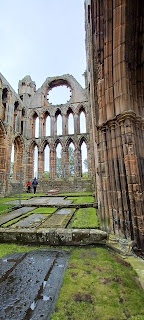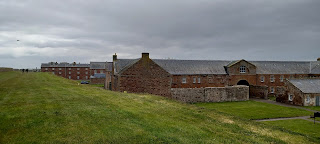In previous posts, we have mentioned Scotland's violent history several times. This post looks at more of that history and some of the places we visited connected with it.
Scotland went through its Protestant Reformation in the 16th century, prior to its union with England in 1707. And unlike England, which switched to Anglicanism by decree of King Henry VIII, the move away from Catholicism in Scotland was more gradual and did not lead to the active destruction of centers of Catholicism. Instead, many Catholic buildings were simply abandoned, and have fallen into ruin with the passage of time. This was the case with Elgin Cathedral.
Elgin Cathedral was started in 1224, and was an extremely important religious center right up until the Scottish Reformation began. It was abandoned, and over 500 years it became a ruin, but with fairly large structures remaining. The photo on the right below is taken from the top of one of the towers in the photo on the left, which can be climbed by tourists willing to navigate several narrow spiraling staircases -- they definitely don't build them like they used to. (Clearly, we were willing and we enjoyed it a lot.)
As long as a hundred of us remain alive, never will we on any conditions be subjected to the lordship of the English. It is in truth not for glory, nor riches, nor honours that we are fighting, but for freedom alone, which no honest man gives up but with life itself.
This plea to the Pope was successful, and Scotland gained the recognition it sought, but the wars continued until 1346. Less than four centuries later, the 1707 Act of Union formally recombined England and Scotland into a single country. Some historians theorize that the Declaration, and the high number of Scottish immigrants to the US colonies at the time, influenced the U.S. Declaration of Independence.
After 1707, the Jacobites attempted several times to return the Stuart family to the throne of Scotland and England. These attempts were finally put down at the 1746 Battle of Culloden. We visited the battlefield, situated just outside of Inverness, which has an impressive exhibition with a lot of detail about the history leading up to the battle, and took an informative tour where we learned more about the battle and its aftermath. Unfortunately, the weather was terribly cold that day and Culloden is really just a large field, so we don't have any worthy pictures. But we learned how the British Army (the Red Coats, only 30 years before the American Revolution) thoroughly defeated the Jacobites at Culloden and subsequently crushed the clan system and lifestyle among the Scottish Highlanders.
The final stop on this history tour is Fort George (a name that is common in British Colonies, but this is the largest Fort George in the world). (British forts are named after the king who ruled when they were built. We visited Charles Fort and saw James Fort while in Kinsale, Ireland.)
Although history shows that Culloden was the end of Scottish uprisings against England, that was not obvious at the time. So, the English soon began buiding a large fort in the area in order to maintain control. Opened in 1769, Fort George remains a British military outpost to this day.









No comments:
Post a Comment